Using the Programmers Pane
Using the Programmer s Pane
The Programmer's pane is opened by default in every design element unless that element has a different design tool, as is the case with the database icon and the About and Using documents. This pane is where all code is produced for the design elements that support the database. Figure 3.10 shows the Programmer's pane.
Figure 3.10. The window title for the form is composed in the Programmer's pane. The Action pane is displayed in the upper-right corner of the Work pane.
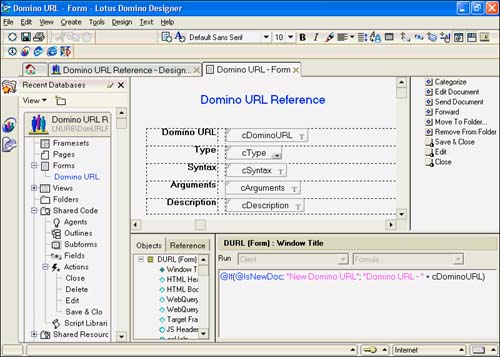
The Programmer's pane displays the name of the design element that you are working with and the event that you are programming.
Under the name, you will notice the Run options (shown in Figure 3.11) that let you choose the type of language being used for the event. You can also choose the type of client, Web or (Notes) Client. Note that not all of the languages listed are available for each design object:
- Formula
- Simple action(s)
- LotusScript
- JavaScript
- Common JavaScript
- Java
- Imported Java
Figure 3.11. The drop-down list in the Programmer's pane for a shared action lists the available languages for a Notes client.
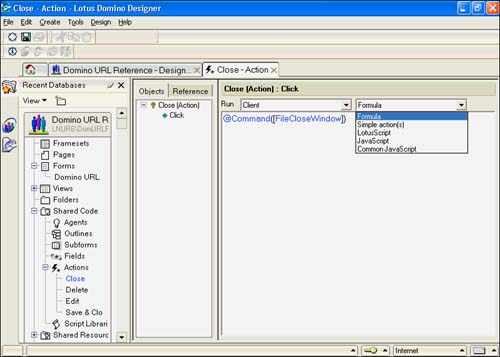
To write the code for an object, you must select the object and the event that should trigger the code. Then choose the client and the language that you will use, and type your code in the Programmer's pane.
You can select the object that you want to work with in two ways. The first is to click the object in the Work pane; the second is to select the object from the Object View box, shown in Figure 3.12. If you have selected the object in the Work pane, the object also is highlighted in the Object View box. Next, you must select the event associated with the object that you want to program. The events that you can program will change based on the object that you select. The list of events for any object is indented under the object name in the Object view. Clicking the plus sign next to the object expands the category so that you can see the list of available events. You can select an event by highlighting it in the Object View box.
Figure 3.12. In the Object View browser, you can select an event to program. When an event is programmed, the icon next to its name is filled.
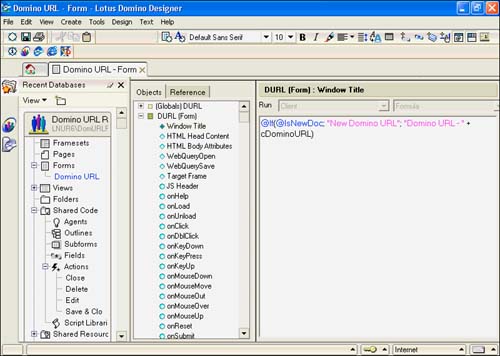
If you are writing LotusScript, a drop-down field titled Errors is opened below the main LotusScript window. When script is saved, Notes checks for syntax errors, which then appear in this field.
TIP
From the Reference tab, you can get help by selecting an object and pressing the F1 key or clicking the Help button. You can also paste a command into the Programmer's pane by clicking the Paste button.
The Agent Design window also has a Programmer's pane. Simple actions, formulas, LotusScript, imported Java, and Java are available there as well. Agents are discussed in detail in Chapter 11, "Automating Your Application with Agents."
TIP
Take advantage of the formatting features for adding comments and for enhancing clarity. Including blank lines after comments separates them from the formulas that follow. Breaking up and indenting portions of complex formulas can significantly improve their readability, thus making code easier to conceptualize and maintain.
The sample code in Listing 3.1 illustrates the use of blank lines and indentations.
Listing 3.1 Formatting Code for Readability
REM "If the doc is not being saved, exit " ;
@If(@IsDocBeingSaved ; @Success ; @Return("") ) ;
REM "If the doc is new, use @Name... etc. " ;
@If(@IsNewDoc cEditors = "" ;
@Name([CN];@UserName) ;
@Subset( (@Name([CN]; @UserName) : cEditors) ; 5)
)
Setting Options for the Programmer's Pane
Of the four panes in the Designer, the Programmer's pane is the only one with its own properties. To open the Programmer's pane properties box, right-click in the Programmer's pane and choose Programmer's Pane Properties from the context menu.
The resulting properties box is shown in Figure 3.13.
Figure 3.13. The Programmer's pane includes a properties box with three tabs. The Font tab is visible in this figure.
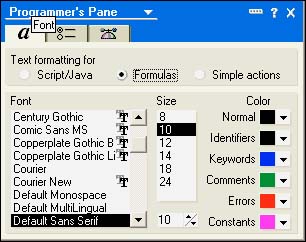
The first tab is the Font tab (see Figure 3.13). The radio button at the top of the Font tab has three choices: Script/Java, Formulas, and Simple Actions. In Release 6, each can have its own default fonts. Except for simple actions, colors can be set for specific language elements such as keywords, errors, constants, and comments. The use of color is a very nice feature, cleanly delineating different sections of code.
The second tab is the Format tab (see Figure 3.14). On this tab you can set formatting options in the Formatting section, including Auto-Indent LotusScript and Auto-Wrap Formulas. In the Options section, you can force the Programmer's pane to add Option Declare to each Options event of LotusScript.
Figure 3.14. The Format tab of the Programmer's Pane properties box lets you control the formatting of LotusScript.
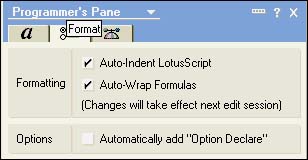
The last tab is the Auto Complete tab (see Figure 3.15). On this tab, you can optionally set Auto Complete and control whether it also autocompletes parameters. You can also set the delay in milliseconds .
Figure 3.15. The Auto Complete tab of the Programmer's Pane Properties box lets you set the behavior for autocompletion of keywords and formulas in the Programmer's pane.
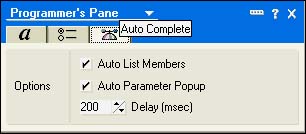
Part I. Introduction to Release 6
Whats New in Release 6?
- Whats New in Release 6?
- A Brief History of Lotus Notes
- Major Features of Lotus Notes
- Types of Applications
- Whats New in Domino Designer?
- New Design Element Features
- New Language Features
The Release 6 Object Store
- The Release 6 Object Store
- Defining a Domino Database
- Understanding the Database Structure
- Creating a Database
- Working with Database Properties
- Understanding Design Templates
- Creating Your Own Templates
- Inheriting Designs from Templates
- Using Templates to Replicate Design Changes
- Using Templates as Design Libraries
- Archiving Versions with Templates
The Integrated Development Environment
- The Integrated Development Environment
- Working in the Application Design Environment
- Working with the Properties Box
- Understanding the Work Pane
- Using the Programmers Pane
- Understanding the Info List
- Understanding the Action Pane
- Customizing the Tools Menu
- Printing Source Code
- Using the HTML Editor
- Locking Design Elements
Part II. Foundations of Application Design
Forms Design
- Forms Design
- Designing Forms
- Setting Form Properties
- Working with Text Properties
- Working with Fields
- Writing Formulas in Fields
Advanced Form Design
- Advanced Form Design
- Working with Tables
- Using Graphic Objects on Forms
- Working with Form-Level Events
- Using Form Actions
- Working with Hotspots
- Understanding Sections and Section Properties
- Using Layout Regions
- Working with Special Forms
- Creating Reusable Design Objects
- Using Embedded Elements
- Using the Form Design Document
Designing Views
- Designing Views
- Defining the Elements of a View
- Creating a View
- Setting View Properties
- Creating Advanced View Selections
- Adding and Editing View Columns
- Using View Column Properties
- Adding Actions to a View
- Creating Calendar Views
- Understanding Folders
Using Shared Resources in Domino Applications
- Shared Resources
- Sharing Images Within a Database
- Creating Shared Files
- Creating Shared Applets
- Shared Code
- Creating Subforms
- Creating Shared Fields
- Creating Shared Actions
- Script Libraries
- Database Resources
Using the Page Designer
- Using the Page Designer
- Understanding Pages
- Working with the Page Properties Box
- Using the Page Designer
- Adding Layers to Your Pages
Creating Outlines
- Creating Outlines
- Creating an Outline
- Working with Outline Entries
- Embedding Outlines
- Adding an Outline to a Frameset
Adding Framesets to Domino Applications
- Adding Framesets to Domino Applications
- Creating a Frameset
- Using the Frameset Designer
- Working with Frames
- Viewing the HTML Source of Your Frameset
- Launching the Frameset
Automating Your Application with Agents
- Automating Your Application with Agents
- Working with Agents
- Creating an Agent
- Working in the Agent Builder Design Window
- Using @Commands in Agents
- Putting Your Agent to Work
- Creating a Complex Agent
- Using LotusScript in Agents
- Creating Web Agents Using Formulas and LotusScript
- Using Java in Agents
- Testing and Debugging Agents, the Agent Log, and Agent Properties
- Agent Properties via the Agent InfoBox
Part III. Programming Domino Applications
Using the Formula Language
- Using the Formula Language
- Overview of the Formula Language
- Knowing Where to Use @Functions and @Commands
- Formula Syntax
- Limitations of the Formula Language
- Working with Statements
- Using Logical @Functions
- Working with Date and Time @Functions
- Working with Strings
- Getting Session and User Information
- Working with Documents
- Retrieving Data with @DbColumn and @DbLookup
- Working with Lists
- Getting User Input
- Controlling the Flow of a Formula
- Error Handling
Real-World Examples Using the Formula Language
- Real-World Examples Using the Formula Language
- Programming Practices
- Using Formulas in Forms and Subforms
- Writing Field Formulas
- Writing View Formulas
- Using Hide When Formulas
- Working with Forms, Views, and Shared Actions
Writing LotusScript for Domino Applications
- Writing LotusScript for Domino Applications
- Software Construction
- Fundamental Elements of LotusScript
- New Technologies and LotusScript
Real-World LotusScript Examples
- Real-World LotusScript Examples
- Real-World Example 1: Importing a Delimited Text File
- Real-World Example 2: Delete a Parent Document and All Its Children: DeleteParentAndChildren
- Real-World Example 3: Schedule an Agent Robot to Refresh All the Documents in a View: Robot-DailyRefreshAllDocs
- Real-World Example 4: Return a Web User to the Place Where He Started After a Document Is Submitted: WebQuerySave-DocSubmit
Writing JavaScript for Domino Applications
- Writing JavaScript for Domino Applications
- What Is JavaScript?
- JavaScript Is Not Java
- JavaScript and the Domino IDE
- The Document Object Model
- JavaScript Support in Domino 6
- When to Use JavaScript
- A Look at JavaScript in Domino
- JavaScript Libraries in Domino
- JavaScript Principles 101
- Syntax and Command Blocks
- Statements
- Output
- Functions
- Objects
- Input Validation
- Validating Check Boxes
- Validating Radio Buttons
- Validating Selection Lists
- Calculations
- JavaScript Application
Real-World JavaScript Examples
- Real-World JavaScript Examples
- Real-World Example 1: Dynamic Drop-Down Lists on the Web
- Real-World Example 2: Dialog Boxes and window. opener on the Web
- Real-World Example 3: Dynamic Tables
- Real-World Example 4: Useful JavaScript Utilities
Writing Java for Domino Applications
- Writing Java for Domino Applications
- Introduction to Java
- Choosing a Java Solution in Domino
- Understanding the Notes Object Interface
- Writing Java Agents
- Using Other Java IDEs
- Other Uses for Java
Real-World Java Examples
Enhancing Domino Applications for the Web
- Enhancing Domino Applications for the Web
- Whats New in Designer 6
- Understanding the Domino Web Application Server
- Understanding the Basics of HTML
- Using HTML in Domino Designer
- Adding Power with Domino URLs
- Views and Forms Working Together on the Web
- Incorporating Flash into Your Web Pages
- What Its All About: XML Exposed
- How Does Domino Use XML?
Part IV. Advanced Design Topics
Accessing Data with XML
Accessing Data with DECS and DCRs
- Accessing Data with DECS and DCRs
- What Is DECS?
- The External Data Source
- DECS Administrator
- Creating the Activity
- Accessing the Application
- DECS Summary
- Data Connection Resources
- DCR Example
- Tips on External Data Access
Security and Domino Applications
- Security and Domino Applications
- How Does Domino Security Work?
- Enabling Physical Security
- Setting Server Access
- Database Access Control Lists
- The Role of the Domino Directory in Application Security
- ACL Privileges
- Enabling Database Encryption
- Using Roles
- Implementing View-Level Security
- Implementing Form-Level Security
- Implementing Document-Level Security
- Applying Field-Level Security
- Hiding the Design of Your Application
Creating Workflow Applications
- Creating Workflow Applications
- The Evolution of Groupware
- Introducing Workflow
- Creating Mail-Enabled Applications
- Using Triggers to Send Email
- Sending Mail with LotusScript
Analyzing Domino Applications
Part V. Appendices
Appendix A. HTML Reference
Appendix B. Domino URL Reference
EAN: 2147483647
Pages: 288
